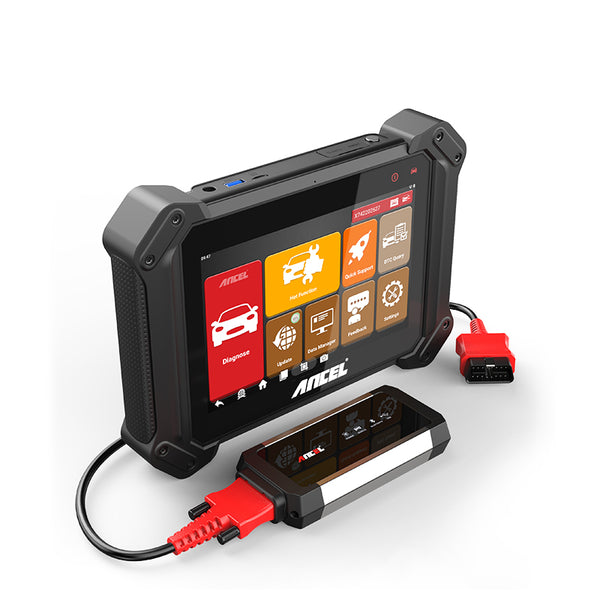An effective scanner not only provides real-time data on your vehicle's functioning but also diagnoses trouble codes that alert you to potential or existing issues.
-
Compatibility: Ensure the scanner supports the make, model, and year of your vehicle. Universal scanners are available, but targeted devices may provide deeper insights.
-
Features and Functionality: Some scanners offer basic code reading and clearing, while others include advanced features like live data viewing, emission status, and even programming capabilities.
-
User Interface: A easy interface with a clear display and intuitive controls enhances the diagnostic process. Touchscreen models can offer an even more seamless interaction.
- Connectivity Options: Modern OBD2 scanners may include Bluetooth or Wi-Fi connectivity, allowing for wireless communication with a smartphone app, where data can be analyzed and stored more conveniently.
Purchasing an OBD2 scanner that fits your technical comfort level and meets your vehicle’s diagnostic needs can save you time and money on car maintenance. You could visit ANCEL to find the perfect one that meets your all need.
Related Reading: What is the Best Code Reader For Cars
Connect Your Scanner to the
The Diagnostic Link Connector is the gateway to initiating a diagnostic check using your OBD2 scanner. Typically located under the dashboard on the driver’s side, the DLC should be easily accessible. Follow these steps to connect your scanner:
-
Locate the DLC: Check your vehicle’s manual for the exact location. It’s generally near the steering column.
-
Ensure the Vehicle is in Park or Neutral: Make sure your vehicle is stationary and securely positioned.
-
Connect the Scanner: Plug the scanner’s connector into the DLC port. Most connectors are designed to fit snugly and only go in one way.
- Power the Scanner: Depending on your model, the scanner might power up automatically upon connection or might require manual powering using the vehicle's ignition key.
Once connected, the scanner will interface with the vehicle’s computer system, ready to relay crucial diagnostic information.

Vehicle VIN and Access the Menu
To begin the diagnostic process, input your vehicle’s Vehicle Identification Number into the scanner.
This ensures that the diagnostic data you receive is specific to your vehicle model. Here's how to proceed:
-
Find Your VIN: Locate your vehicle’s VIN on the registration, insurance card, or embossed on the vehicle's body (dashboard or driver-side door frame).
-
Enter the VIN: Use the scanner’s keypad or touchscreen to input the VIN. This step helps tailor the scanner’s analysis to your specific vehicle.
- Navigate the Scanner’s Menu: Use the scanner’s menu to access various functions. You can view error codes, examine real-time data, and more.
Accurate VIN entry is essential for retrieving the correct information and avoiding misdiagnoses.

Identify and Understand the Codes
OBD2 scanners display codes that typically start with a letter followed by four numbers (e.g., P0301). Each code corresponds to a specific issue.
Many scanners come with a built-in database or reference guide. For more comprehensive information, online databases provide detailed explanations.
Some issues may trigger permanent codes while others result in temporary alerts that clear once the issue is resolved.
OBD2 scanners display codes that typically start with a letter followed by four numbers (e.g., P0301). Each code corresponds to a specific issue. The initial letter indicates the category of the issue:
-
P for Powertrain, which covers the engine, transmission, and associated systems.
-
C for Chassis, involving systems like the braking, steering, and suspension systems.
-
B for Body, which includes components such as power seating or airbags.
- U for User network, related to components like wiring and data links.
Below are some common codes and their interpretations:

Tips to Save on Costly Car Repairs
Maintaining a vehicle can be expensive, but using an OBD2 scanner effectively can lead to substantial savings. Here are some tips:
-
Regular Diagnostics: Frequently check your vehicle for any new codes. Early detection of issues can prevent them from escalating into more costly repairs.
- Understand the Severity of Issues: Some codes may indicate minor issues that you can address yourself, such as replacing a sensor. Others might signal severe problems that require professional attention.
By using an OBD2 scanner, you can enhance your vehicle’s longevity and performance while keeping repair costs manageable.
Conclusion
Mastering the use of an OBD2 scanner can significantly influence your vehicle's maintenance strategy, empowering you to take control of your vehicle's health and operational status, thereby minimizing unexpected repair costs and ensuring that your vehicle remains in peak condition.
The best car scanner is in ANCEL, enter ANCEL to get more information about car scanning tools!
FAQs
What is a car scanner and how does it work?
A car scanner is a device used to diagnose issues with a vehicle’s engine and other systems by accessing the car’s onboard computer. It reads data from the vehicle's diagnostic system, including error codes that help identify mechanical or electrical problems.
What types of car scanners are available?
There are several types of car scanners, including basic code readers that only read codes, professional-grade scanners with extensive capabilities, and Bluetooth or wireless scanners that work with a smartphone app.
Can a car scanner work on any vehicle?
Most modern car scanners are designed to be compatible with a wide range of vehicles, especially those manufactured after 1996 in the United States, as they are equipped with a standardized OBD-II port. However, compatibility with specific features may vary based on the scanner model and the vehicle’s make and model.










